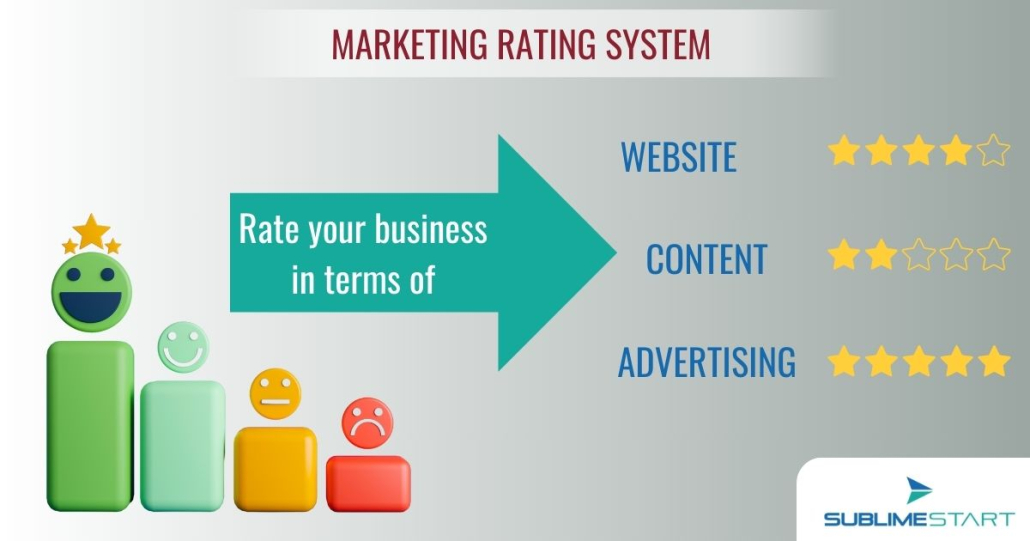What is the Marketing Rating System?
Successful marketing requires clear expectations and collaboration. SublimeStart’s Marketing Rating System helps you set realistic goals. It takes you through a quick assessment to understand your current marketing situation and what components can use an upgrade. In this article, you will learn more about the Marketing Rating System.
What is the Marketing Rating System (MRS)?
SublimeStart designed a self-analysis and scoring system for three essential areas in Marketing: Website, Content, and Advertising. Each of the categories has 10 sub-areas to get a more detailed analysis. With the system you can visualize the action plan and manage expectations of online marketing improvements.

The challenge of marketing
No business can have the same strategic plan because the strengths and weaknesses -concerning marketing- are different. Now, how do you know which areas of your business need improvement and which are already up to par.
The issue is that not all marketing will generate leads (at least not in the short term). A client who doesn’t know what they will receive can be frustrated when the set goals such as lead generation, awareness, and improvements are unmet.
Some marketing is purely for branding purposes while other is more on lead generation (also called marketing performance). Consequently, some marketing will generate leads faster, while other marketing might optimize lead generation with just a few percentages. The MRS therefore doesn’t focus on lead generation or branding alone, but more on the components that are necessary for the best marketing.
The result of the rating is the Marketing Status, which should have a time stamp attached to it. The Marketing Status can help you understand how your marketing is going on the core services of SublimeStart we named above: Advertising, Website, and Content.
Rating System
The three pillars are divided into 10 sub categories. The average of these subcategories will determine the overall score of the main category. Rating is done on a level of 0 to 5 stars: 0 star being non-existent. 5 stars meaning perfect.
The marketing rating system should be used by people who understand the marketing aspects.
Below are the three key pillars of the Marketing Rating System.
Website
Businesses need a website to establish a place where information can be found. Questions to rate your website are:
- Responsiveness: How well does the website adjust its layout and content for different screen sizes (desktop, tablet, mobile)?
- Analytics: To what extent does the website provide clear and actionable data on user behavior?
- Chatbot: How helpful and informative is the website’s chatbot in answering your questions and helping the audience convert?
- Email signup: How easy is it to sign up for the website’s email list?
- Contact form and information: How easy is it to find and use the website’s contact form or locate contact information?
- Page design and branding: How well does the website’s design reflect its brand identity and create a visually appealing experience?
- Funnel: How effectively does the website guide users towards taking a desired action (e.g., purchase, signup)?
- Speed: How quickly does the website load content on device?
- Navigation: How easy is it to find the information you’re looking for on the website?
- Technical SEO: How well is the website optimized for search engine indexation?
Content
Content is all the information that your business brings to market.
- Reviews and testimonials: How credible and helpful are the website’s reviews and testimonials?
- Blog: How informative and engaging is the website’s blog content?
- Newsletter: How valuable and relevant is the information provided in the website’s newsletter?
- Social Media: How well does the website’s content integrate with and leverage its social media presence?
- Lead magnets: How valuable and enticing are the website’s downloadable offers (e.g., ebooks, white papers) in exchange for contact information?
- Presentations and Infographics: How visually appealing and informative are the website’s presentations and infographics?
- Product / service information: How clear, comprehensive, and easy to understand is the website’s information about its products or services?
- Branding designs / brand kit: How well do the website’s visuals (logos, colors, etc.) align with and reinforce its overall brand identity?
- SEO content: How well is the website’s content optimized for search engines?
- Images and video’s: How visually appealing, high-quality, and relevant are the website’s images and videos?
Advertising
Advertising is how an organization reaches their target audience also called paid online advertising.
- Image and video ad design: How visually appealing and attention-grabbing are the advertisement’s images and videos?
- Advertisement text and design: How clear, concise, and persuasive is the message conveyed by the advertisement’s text and design?
- Advertisement Landing page: How well does the landing page associated with the advertisement fulfill its intended purpose (e.g., generate leads, drive sales)?
- Retargeting setup: How effective is the retargeting strategy used in the advertising campaign?
- Campaign structure: How well-organized and logical is the overall structure of the advertising campaign?
- Target group definition: How well-defined and relevant is the target audience for the advertising campaign?
- Product showcasing: How effectively does the advertisement showcase the benefits and features of the product or service?
- Media channel optimization: How well-chosen is the media channel (e.g., search engine, social media) for reaching the target audience with advertisements?
- Search engine advertising: How effective is the advertisement in terms of appearing for relevant search queries?
- Social media advertising: How effective is the advertisement in terms of appearing in front of social media audiences?
Primary benefits
- Onboarding: Helps identify areas needing improvement.
- Progress: Assess your marketing’s effectiveness over time.
- Evaluation: See the success of specific marketing improvements.
Secondary benefits
- Understand your current marketing status: Provides a baseline score, allowing you to track progress over time.
- Set KPI’s: Knowing your marketing’s current status helps you set achievable goals aligned with your budget and timeframe.
- Identify areas for improvement:With the subcategories The MRS pinpoints specific areas where your marketing can be strengthened.
- Make informed decisions: Data-driven insights from the MRS help you prioritize marketing investments.
Get your Marketing Rating today
Ready to see where your marketing stands? Fill in the Marketing Rating System here so you can take new steps towards achieving business success. Remember it’s free!






